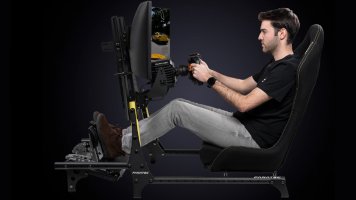Finally we will say goodbye to the excessive configurations of the negative toe in Assetto Corsa Comeptizione! A substantial update of the Kunos simulator is in fact scheduled for release on April 19, together with the upcoming DLC GT World Challenge 2023, with a large number of changes to the general physics of the simulation.
The 1.9 update is the first update with a significant impact on physics, since the 1.8 release of November 2021. Yesterday and also today at 18, Aristotelis Vasilakos, Head of Vehicle and Handling R&D of Kunos Simulazioni, told on his YouTube channel all the details of the news. These physical changes will affect and update areas such as tire pressures and usage temperature ranges.
The pressures will have a wider window to work in, so it feels more realistic, to give the tires more or less flex, traction, movement, lateral support and how much heat is being generated at different points on the tires. In theory, being able to find perfect grip at 26.5 psi should no longer be possible.
The way the tire flexes will become more apparent. Using different pressures from front to back can increase stability or aid rotation. In theory, a high-speed, high-downforce cornering requires higher pressures to offer more support and less tire flex. A low-speed, low-downforce cornering requires lower pressure to provide more flexibility. There will now be a slightly wider tire temperature range, with a core of 70C-100C, but potential sudden lows of 50C and highs of 120C. This means that monitoring the difference between outside and inside temperatures is as crucial as ever, with suspension alignment (camber and toe) having the
According to Aris, there will be more vehicle rotation under acceleration, which means that negative toe setups should be banned permanently. Thanks to the tire temperature changes, setups with negative toe values or ridiculously high camber should overheat the tires, negating any advantage. For example, a high toe-in value should now overheat the inside of the tire, while at the same time the outside will become too cold. This will be valid for all cars.
"Negative convergence is not realistic, too much negative convergence shouldn't give the performance advantage it is giving in version 1.8," Aris explained. "That's not to say that some real teams don't use negative spikes occasionally or in some situations, but they keep it to a minimum and usually don't think about gaining in other areas. We're not saying 'we limited negative toe' and that's it. If had we done that, we would have never discovered the limits of our physics engine. Now we know it and we have tried to overcome it and try to make it more realistic."
For now, the version 1.9 update will only be available for PC, along with the latest DLC, with consoles expected to follow at a later date. Naturally, we advise you to follow all the Aris videos, listed below.
The second live stream, on the other hand, will tell us about the suspension changes, at 18:00 today.
The 1.9 update is the first update with a significant impact on physics, since the 1.8 release of November 2021. Yesterday and also today at 18, Aristotelis Vasilakos, Head of Vehicle and Handling R&D of Kunos Simulazioni, told on his YouTube channel all the details of the news. These physical changes will affect and update areas such as tire pressures and usage temperature ranges.
The pressures will have a wider window to work in, so it feels more realistic, to give the tires more or less flex, traction, movement, lateral support and how much heat is being generated at different points on the tires. In theory, being able to find perfect grip at 26.5 psi should no longer be possible.
The way the tire flexes will become more apparent. Using different pressures from front to back can increase stability or aid rotation. In theory, a high-speed, high-downforce cornering requires higher pressures to offer more support and less tire flex. A low-speed, low-downforce cornering requires lower pressure to provide more flexibility. There will now be a slightly wider tire temperature range, with a core of 70C-100C, but potential sudden lows of 50C and highs of 120C. This means that monitoring the difference between outside and inside temperatures is as crucial as ever, with suspension alignment (camber and toe) having the
According to Aris, there will be more vehicle rotation under acceleration, which means that negative toe setups should be banned permanently. Thanks to the tire temperature changes, setups with negative toe values or ridiculously high camber should overheat the tires, negating any advantage. For example, a high toe-in value should now overheat the inside of the tire, while at the same time the outside will become too cold. This will be valid for all cars.
"Negative convergence is not realistic, too much negative convergence shouldn't give the performance advantage it is giving in version 1.8," Aris explained. "That's not to say that some real teams don't use negative spikes occasionally or in some situations, but they keep it to a minimum and usually don't think about gaining in other areas. We're not saying 'we limited negative toe' and that's it. If had we done that, we would have never discovered the limits of our physics engine. Now we know it and we have tried to overcome it and try to make it more realistic."
For now, the version 1.9 update will only be available for PC, along with the latest DLC, with consoles expected to follow at a later date. Naturally, we advise you to follow all the Aris videos, listed below.
The second live stream, on the other hand, will tell us about the suspension changes, at 18:00 today.












